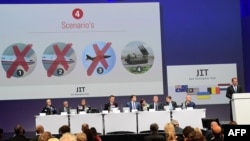On March 18, Ukrainian ex-military pilot Vladyslav Voloshyn died in a hospital in Mykolaiv from a self-inflicted gunshot wound. Voloshyn had been decorated for his service during the Russian-Ukrainian war in 2014, when he flew an Su-25 ground attack aircraft in air support missions. During the battle of Illovaisk in August-September 2014, his plane was hit and he was forced to eject over enemy territory. After hiding in a village for several days, Voloshyn managed to escape to friendly lines.
The day after his suicide, Russia’s RIA Novosti state news agency published two articles about the incident. Both mentioned that Voloshyn had been accused of shooting down Malaysian Airlines flight MH17 on July 17, 2014, killing 298 people. One article cited a political commentator who alleged that Voloshyn had been killed because he was a “dangerous witness,” while another presented a Facebook post by one of Voloshyn’s friends, who claimed that Voloshyn did not suffer from depression.
In December 2014, Russia’s Investigative Committee claimed to have an anonymous witness who served as part of the ground crew on the base where Voloshyn was stationed and who could implicate him as a suspect in the downing of MH17. This witness allegedly saw Voloshyn’s plane return to base without its missiles. The witness also claimed Voloshyn looked agitated and upset after the mission. However, Voloshyn said that incident occurred six days after the downing of MH17. He also said his jet was armed with air-to-ground missiles and he was upset because two of his fellow pilots had been shot down during the mission.
The theory that MH17 was shot down by a military plane using an air-to-air missile has been thoroughly debunked, primarily on technical evidence. An Su-25, the plane most often alleged to have shot the airliner down, is not capable of flying high enough or fast enough (especially with weapons) to have shot down a Boeing 777 flying at MH17’s altitude at the time. More importantly, the damage to MH17 and the manner in which it was hit and broke up rule out an air-to-air missile in favor of a surface-to-air missile with a much larger warhead.
This is what the Dutch Safety Board and Joint Investigation Team concluded. According to their investigations, MH17 was shot down by a Russian-manufactured Buk surface-to-air missile system. While the RIA Novosti article mentions this, it falsely claims that the other investigations relied solely on evidence provided by Ukraine. The RIA Novosti article also mentions that Almaz-Antey, the manufacturer of the Buk, carried out its own investigation and concluded that MH17 was brought down by a Buk, but that it was fired from territory that was under the control of the Ukrainian military at the time (which was found to be incorrect).
The Russian Defense Ministry and its media outlet, TV Zvezda, have also alleged that MH17 was shot down by a Ukrainian-operated Buk surface-to-air missile. While these alternate theories at least get the weapon correct, they have been debunked by other investigations and contradict claims about Voloshyn or an air-to-air missile.
There is also the question of Voloshyn’s motive for committing suicide. The Kyiv Post reported that Voloshyn may have been in trouble with the law in connection with his position as director of Nikolaev Airport. A local journalist named Andriy Lokhmatov found correspondence between Voloshyn and a friend, in which Voloshyn expressed concern for his career and said he felt suicidal.
Also, Voloshyn’s wife and two children were in his apartment at the time of his suicide attempt, casting doubt on the idea that the gunshot was actually inflicted by an assassin. Ukrainian police have opened a case in the matter, however, and are examining several possible motives for Voloshyn’s suicide. They have also not ruled out the possibility that the shooting was an accident.








